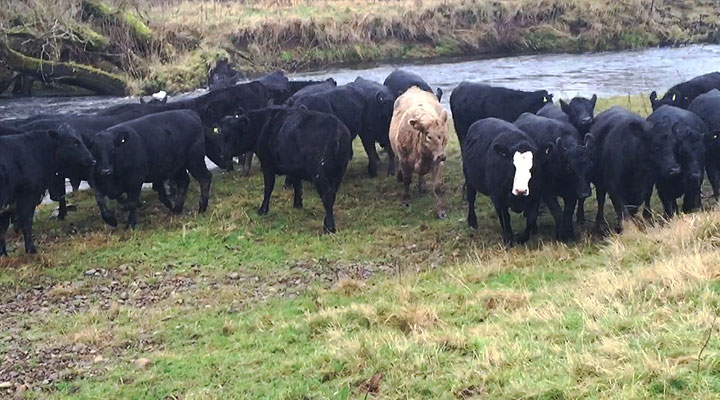Pasture for Life – Case Study – Duncan and Angus Nelles, Northumberland
Fifteen years ago the Nelless family set a goal to farm in an enjoyable and rewarding way without relying on subsidies to make a profit. Amongst other things, a focus on strict grassland management and organic conversion has allowed them to do this.
A pedigree flock of 2,000 Lleyn ewes are run (500 to terminal sire). Those not meeting the criteria for the pedigree flock are mated with the Hampshire Down to produce slaughter lambs from late June onwards. 40 Lleyn performance recorded shearling rams are sold annually Recording from birth has enabled selection for worm resilience, reduced lambing assistance, improved udder conformation, increased maternal drive and addressed other management issues.While the flock is grass-fed, the feeding regime of bought-in stores cannot at the moment be guaranteed, so the sheep are not yet certified 100% ‘Pasture for Life’. However, the cattle enterprise is fully certified.
While the flock is grass-fed, the feeding regime of bought-in stores cannot at the moment be guaranteed, so the sheep are not yet certified 100% ‘Pasture for Life’. However, the cattle enterprise is fully certified.
Last spring 175 Aberdeen Angus suckler cows calved. Angus, who looks after the cattle, has just started introducing Hereford breeding to produce low-input Black Baldies.

“We are looking for the quiet temperament of the Hereford, as we have to move the cows around quite a bit as they graze the fields rotationally with the sheep,” Angus explains.
“We choose bulls on their Estimated Breeding Values, looking for average 400-day weights, easy calving for the mother and for her daughters, as well as other things like good testicle size and good feet.”
Compact calving
The bulls go in on 25 June and the cows start calving on 1 April. They carry on calving for seven weeks only, to keep the calving period compact. They are pregnancy scanned early in October and this year there were 97% in calf. Any not pregnant are culled immediately.
During the spring, summer and autumn, three mobs of cows and one of heifers are assigned to grazing areas within the 530ha of grassland. One third is traditional ridge and furrow, one third is permanent pasture and the final third is down to temporary grass and forage crops.
The calves are weaned in November at housing and fed good quality red clover silage.
The cows are fed a mixture of stewardship hay and moderate quality silage.
“In winter we are looking for growth gains for the calves of around 0.6kg/day,” says Angus. “Then we want an early turnout, ideally at 20 March, to make the most of fast compensatory growth of 1.2kg/day, up to a finishing deadweight of 320kg. That is the target.”
Steers finish at 18 to 20 months of age and are currently sold to Dovecote Park. The family already retails the products from their 6,000 free-range chicken enterprise, so would rather not sell their beef themselves.
“At the moment the beef cattle enterprise works well – due to low costs, high fertility, very good compensatory growth and rotational grazing,” says Angus.
“The cows gain condition over the summer, which they draw on to survive the winter. There is no machinery or concentrate feeds, just grazed grass and hay bales or pit silage for the winter.
Grass measurement
“The rotational grass is not in for a fixed length of time. We measure the grass monthly, so we know how much grass each one is giving, which helps us pinpoint the under-performing ones and replace those.
“There are 32ha of a red clover and perennial ryegrass mixture. We take two cuts of silage for the steers, and then finish lambs on it for the rest of the season.
“We started down the grass route in 2007 and it has allowed us to completely transform the whole system. Farming this way is not rocket science; it’s just a mixture of the old and the new.”



